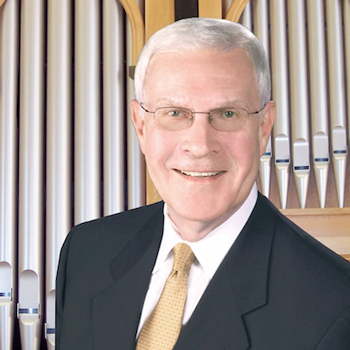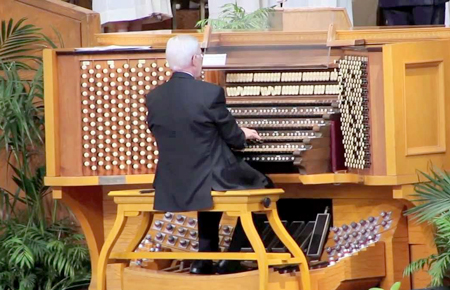by Daniel Hathaway

The longtime organist of New York City’s Riverside Church and organist emeritus of the Crystal Cathedral in Garden Grove, California has decided at the age of 85 to wind down his career as one of the most celebrated recitalists in North America. This fall he will play his last two recitals: in Cleveland on October 2 and in Kilgore, Texas, on November 10.
That penultimate concert will bring Swann back to the 100-rank Schantz instrument in Fairmount Presbyterian Church in Cleveland Heights on Sunday, October 2 at 3:00 pm. His program, co-sponsored by Arts at Fairmount and the Cleveland Chapter of the American Guild of Organists, will include music by Seth Bingham, César Franck, John LaMontaine, J.S. Bach, John Weaver, Ernst Pepping, and Healey Willan.
Then for his final recital, Swann will time-travel back to First Presbyterian Church in Kilgore. “They’ve asked me to play the program I played 50 years ago to dedicate the organ — on the same date and at the same hour. It’s a marvelous Aeolian-Skinner instrument that had the country’s first trompette-en-chamade [a powerful reed stop whose pipes project horizontally from the back wall of the church]. So I thought I’d stop right then and be thankful for having made it that far.”
Though he’s giving up concertizing, Swann will continue in his current position as organ artist in residence at St. Margaret’s Episcopal Church in Palm Desert, but plans to cut back considerably at the University of Redlands, where he serves as University Organist. “I have two students left to get through their degrees. So I have one more year after this one, and then I’m going to hang it up.”
Throughout his career, Frederick Swann has had the privilege of presiding over a series of enormous pipe organs. Early on, he found himself multitasking around New York City. “Before I came to Riverside, I had been Harold Friedell’s assistant at St. Bartholomew’s — a big five-manual instrument. And there was one year before I went to Riverside full-time when Clarence Dickinson had a heart attack, so I would fill in for him at Brick Presbyterian. Then, I’d run down to St. Bartholomew’s to play the Evensong service. And on more than one occasion, I had to play the 6:00 oratorio the same day at Riverside. I would finish the oratorio, jump off the bench, and dash downstairs, where there was a car waiting that got me to Riverside just in time.
“Even though both St. Bart’s and Riverside had enormous Aeolian-Skinners, there were many things that were different about the setup of the consoles. When you’re young, you don’t think about things like that. You just think, isn’t this fun! Almost all my career until now, I’ve never played anything but big, five-manual organs. But I do enjoy smaller instruments. It’s a challenge to get the best out of a two-manual or a small three-manual organ, but I delight in always using an instrument to its fullest.”
I asked Swann if Virgil Fox, who was organist at Riverside during his early years as a substitute, had much influence on him. “To tell you the truth, not a great deal. I learned a lot from watching him — I saw things I didn’t want to do. For example, a simple prayer response chord required a two- to three- minute improvisation. I was his first substitute for five years before I was hired at the church, and I had known him for years before I went to New York. I admired Virgil — he was a wonderful influence for getting the public to know about and appreciate the organ, and he certainly had as many admirers as he did detractors. I always felt like I was never going to be anything when I saw him play.”
After Riverside, Swann was invited by Robert Schuller to become organist at the Crystal Cathedral in Garden Grove, California, where he presided over huge instruments by the Italian firm of Ruffatti. How did he deal with tuning issues with a pair of organs that were essentially situated in a huge greenhouse in sunny Southern California (below)?

“Now, of course, the Catholic diocese bought the cathedral and the organ is back in this country awaiting reinstallation, but the building renovation is two or three years behind. At 85, I’m not sure I’m going to live long enough to see the end of that project, but I’ll try.”
I asked Swann to talk about his Cleveland program. “I played a recital on the Fairmount organ about 20 years ago, and I’m repeating two of those pieces: the Franck b-minor Chorale and the Healey Willan Introduction, Passacaglia, and Fugue. I remember that the organ has lots of color possibilities, so I hope to show off everything it can do.
“Originally I picked the Willan because the Fairmount organ has both a big tuba and a trompette-en-chamade. It used to be that I was about the only one who ever played the piece, but in recent years a lot of people started to record it — so I stopped playing it! But I’m resurrecting it this year.
“Seth Bingham’s Bells of Riverside uses a pattern derived from a theme in Wagner’s Parsifal. I’ll probably play the tune first on the chimes. It’s a very interesting, well-written piece that I haven’t performed in years.”
And John La Montaine’s Even Song? “John only composed two or three organ pieces, and this is the only one he published. He’s a much under-appreciated American composer who won many prizes, including a Pulitzer. It’s not very long and mostly quiet — an atmospheric, relaxing piece.
“John Weaver is also a personal acquaintance. Introduction and Fugue on “St. Denio” is a piece that the Crystal Cathedral Choir commissioned as a surprise when I retired in 1998. Being an organist, John really knows how to write for the instrument.”
As the sun sets on his own career, and from his vantage point as past National President of the American Guild of Organists, how does Frederick Swann feel about the future of the organ in the United States?
“I’m very optimistic. There are so many really outstanding young players now. Here in Los Angeles we have very well-supported recital series at Disney and Segerstrom halls and two or three big churches. Over the years, all the recordings have helped. Even people who really didn’t care about organ music bought CDs to test their sound systems. Many church situations are still kind of glum, and it’s difficult to make a living unless you’re in a very prominent place and play a lot of recitals. There are also a lot of big organs being built, as well as smaller instruments. I can’t help but feel if there’s ever going to be a collapse, it’s going to be decades away.”
Published on ClevelandClassical.com September 27, 2016.
Click here for a printable copy of this article


